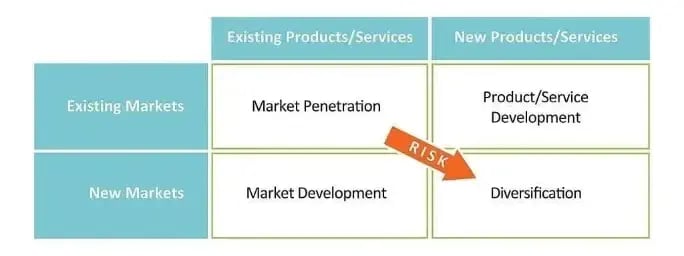
When it comes to developing a strategy for growing a business, we still refer to a model that is over sixty years old. It’s a testament to its worth that the basics have stood the test of time.
Developed in 1957 by Igor Ansoff (known as the father of strategic management), the Ansoff Matrix looks at two possible directions for growth strategy – products and markets.
Although the model traditionally speaks of products, you can substitute services for products and it works equally well. It’s also a model that is relevant to both B2C and B2B.

As well as the four possible strategies, the matrix also suggests a risk factor, with the top left being the least risky strategy and bottom right – diversification – being the riskiest.
Let’s look at all four strategies, how they relate to B2B business and what marketing activities support each one.
Market Penetration
This is the safest of the four strategies – take an existing product or service and grow your market penetration. It is essentially a marketing-led strategy in which you put maximum effort into your marketing. It assumes that you make no major changes to your product or service but concentrate on capturing the market.
In practice, this generally means developing a well-recognised brand, a reputation for being the best in the field (or the cheapest – arguably an equally valid approach) and becoming the brand most associated with that product or service.
This requires a significant marketing budget, directed towards brand awareness and recognition. This implies creating a lot of content and making sure that potential buyers can find you easily. In fact, for this strategy to work, you will need to support multiple channels with multiple media.
Market Development
Staying with the existing product or service but exploring new markets is the basis of this strategy. It will still involve a lot of marketing, but with an element of research, trial and testing.
Content will be aimed more towards the awareness stage of the buyer's journey. It’s possible that you may be able to put the brand equity you have in your core market to good use if there is some overlap between the customers in both markets, but it is more likely you will be pitching to prospective buyers who have never heard of you.
Producing marketing content that establishes authority in the new market, that creates a track record – case studies and the like – is going to be the main thrust of content development here.
Product/Service Development
Like market development, this is a medium risk approach, developing new products or services that you can sell to your existing customer base and existing market.
So rather than marketing focussed – this is driven by product or service development. In theory, at least, you should already have an established reputation and knowledge of the market, so you can utilise these in your marketing campaigns.
Here your marketing collateral should be all about knowledge; creating content that informs and educates existing customers and prospective buyers about your move into new product areas. But researching what the market needs, and what your customers and prospective buyers are looking for, is the key to success.
Diversification
It’s said that the greater the risk, the greater the reward. And this last of the four main strategies is the highest risk approach.
Developing a new product or service in a new market. The marketing strategy here most resembles that you would follow if you were a start-up business – as that is what is implied by this approach. This strategy requires a lot of prior research and investigation – you would really want to be sure you know what you are doing before you launch a new product or service in a new market.
Like Market Penetration, this strategy requires a lot of content. As well as creating awareness of the product or service, in a new market, you will also have to build brand awareness. Informing and educating the market becomes important, along with establishing authority and all the elements of lead generation and follow-up; using content such as eBooks to encourage prospective buyers to engage.
Hybrid Approach
It is recognised that any company may well be engaging in more than one of these strategies at a time. You may look at market penetration with an existing product whilst simultaneously launching a new product.
Although following too many different strategies at once, isn’t really a strategy and the danger here is that you might not have enough resources to successfully implement multiple growth strategies.
Portfolio Approach
Medium to large companies often have a portfolio of products and services – and these could be following different growth strategies. Many of you will probably be familiar with the Boston Matrix (or Growth-share Matrix)– which aims to analyse products – looking at whether they are stars, question marks, cash cows or dogs – to determine which are worth investing in and which should be quietly terminated.
The implication being that a portfolio of products (and/or services) that spreads the risk of growth strategies is a better approach if you have the resources. This means that you can follow a more risky growth strategy with one product or service which is then balanced by a safer, more conservative growth strategy for another product or service.
Which of these four classic growth strategies for a business you choose, comes down to a whole host of factors – how risk averse a business you are, how much you have to invest, and what resources or capabilities you have. One thing they all have in common is the high level of marketing commitment they all need, and the associated content required to follow through.



